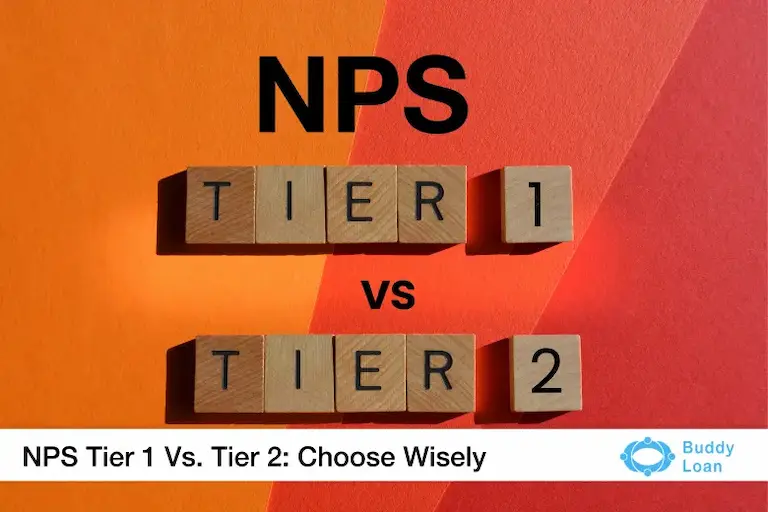The National Pension System (NPS) is a government-backed, voluntary retirement savings scheme in India, designed to provide long-term financial security. It offers two types of accounts: Tier 1 and Tier 2. Each has unique features and serves different purposes, allowing individuals to tailor their retirement savings based on their financial goals. In this blog, we’ll explore the NPS Tier 1 vs Tier 2 differences, helping you make an informed choice based on returns, tax benefits, and flexibility.
Tier 1 NPS Account
The Tier 1 NPS account is the primary pension account to build a retirement corpus. It is a long-term, defined contribution account with several restrictions on withdrawals.
Eligibility
Open to Indian citizens (resident or non-resident) and OCI cardholders aged between 18-70 years.
Investment Options
1. Subscribers can choose from various asset classes: equity (E), corporate bonds (C), government securities (G), and alternative investments (A).
2. There are two approaches: Active Choice (you choose the asset allocation) or Auto Choice (funds are managed based on your age).
Tax Benefits
1. Contributions up to ₹1.5 lakh are tax-deductible under Section 80C of the Income Tax Act.
2. An additional ₹50,000 is deductible under Section 80CCD(1B), offering tax benefits up to ₹2 lakh in total.
Exit Options
1. Partial withdrawals of up to 25% are allowed after 3 years for specific purposes like education, medical treatment, or buying a home.
2. Full withdrawal is permitted after retirement (at 60 years), but 40% of the corpus must be used to purchase an annuity, while the remaining 60% can be withdrawn tax-free.
Tier 2 NPS Account
The Tier 2 NPS account is a voluntary savings account offering more flexibility than Tier 1, but it must be linked to an existing Tier 1 account. It’s designed for individuals seeking additional savings options that can be accessed more freely.
Eligibility
Available only to individuals who already have an active Tier 1 NPS account.
Investment Options
1. Like Tier 1, you can choose between the same asset classes (equity, corporate bonds, government securities, and alternative investments).
2. More flexibility compared to Tier 1 as there are no restrictions on withdrawals.
Tax Benefits
No immediate tax benefits for Tier 2, but government employees can claim deductions under Section 80C if they lock the account for 3 years.
Exit Options
Withdrawals are flexible; you can withdraw your entire balance at any time without restrictions or penalties.
Differences Between Tier 1 and Tier 2 NPS Accounts
Let us look at the key differences between the Tier 1 and Tier 2 NPS accounts since we have looked at the definition :
| Aspect | Tier 1 NPS Account | Tier 2 NPS Account |
| Purpose | Long-term retirement savings | Flexible, additional savings option |
| Eligibility | Open to all Indian citizens | Requires an active Tier 1 account |
| Investment Options | Same as Tier 2 | Same as Tier 2, but with more flexibility |
| Tax Benefits | High tax benefits under Sections 80C & 80CCD(1B) | No tax benefits (except for government employees) |
| Exit Options | Limited partial withdrawals; mandatory annuity | Full withdrawal anytime without penalties |
| Lock-in Period | Until age 60 (for retirement corpus) | No lock-in; withdraw as needed |
| Returns | Market-linked returns based on asset choice | Market-linked returns based on asset choice |
Choosing the Right Tier – Tier 1 vs Tier 2 NPS
The choice between Tier 1 and Tier 2 NPS accounts depends on your financial goals and retirement plans. Here’s a brief comparison:
Tier 1: Best for long-term retirement planning, offering significant tax benefits and mandatory savings until retirement.
Tier 2: Suitable for those looking for additional savings with the flexibility to withdraw funds without penalties.
If your focus is retirement savings with tax benefits, Tier 1 is the right choice. If you want a flexible savings account with access to funds when needed, Tier 2 could be more beneficial.
NPS Tier 1 vs Tier 2 Returns
Both Tier 1 and Tier 2 NPS accounts offer market-linked returns, and there is no fixed interest rate. Returns depend on the asset allocation you choose (equity, corporate bonds, or government securities). On average, NPS returns range between 8% to 10% annually.
NPS Tier 1 vs Tier 2 Calculator
You can use an NPS calculator to estimate the potential growth of your investments in both Tier 1 and Tier 2 accounts. Simply input your contribution amount, the expected rate of return, and the investment duration to calculate your retirement corpus.
To calculate potential returns for NPS Tier 1 and Tier 2, you can use a formula based on the compound interest model, as NPS offers market-linked returns.
Formula:
A = P
Where:
A = Final amount (maturity value)
P = Principal amount (monthly contributions)
r = Annual return rate (e.g., 8%)
n = Number of times interest is compounded annually (generally, NPS returns are calculated yearly)
t = Investment duration in years
For Tier 1 and Tier 2, you can use an online NPS calculator, inputting your monthly contribution, expected return rate, and investment period to calculate your corpus.
NPS Tier 1 and Tier 2 Interest Rates
There is no fixed interest rate in either Tier 1 or Tier 2 accounts, as both offer market-linked returns. However, over the years, NPS has delivered competitive returns compared to traditional pension schemes. Equity investments typically offer higher returns, while government bonds provide more stability with moderate returns.
Conclusion
In summary, both NPS Tier 1 and Tier 2 accounts provide excellent avenues for retirement savings, but they cater to different financial needs.
Tier 1 is ideal for individuals looking to build a retirement corpus with tax-saving benefits. It comes with more restrictions but ensures a disciplined approach to saving for the future.
Tier 2 is a flexible option for those who already have a Tier 1 account and want the freedom to save and withdraw as needed, without tax benefits or lock-in periods.
Understanding the key differences between NPS Tier 1 and Tier 2 will help you make an informed decision based on your retirement goals and financial needs. For personalized advice, it’s always best to consult with a financial advisor to ensure that your NPS investments align with your long-term financial plan.
Frequently Asked Questions
Q. Which is better in NPS, Tier 1 or Tier 2?
A. NPS Tier 1 is better for long-term retirement savings with tax benefits, while Tier 2 offers more flexibility but no tax incentives.
Q. Is NPS Tier 2 withdrawal taxable?
A. Yes, NPS Tier 2 withdrawals are fully taxable as per your income tax slab.
Q. Is NPS Tier 1 tax-free?
A. Contributions to NPS Tier 1 are tax-deductible under Section 80C and 80CCD(1B), but withdrawals are partially taxable.
Q. What is the lock-in period for NPS Tier 1?
A. The lock-in period for NPS Tier 1 is until the subscriber reaches 60 years of age.
Q. What is the disadvantage of NPS Tier 2?
A. NPS Tier 2 lacks tax benefits and is more suited for short-term investment with greater liquidity.
Q. Can I convert NPS Tier 1 to Tier 2?
A. No, you cannot directly convert NPS Tier 1 to Tier 2, but you can hold both accounts simultaneously.
Q. Who is eligible for NPS Tier 2?
A. NPS Tier 1 account holders are eligible to open a Tier 2 account.
Q. Which account type is better in NPS?
A. Tier 1 is better for retirement savings due to its tax benefits and long-term growth.
Q. Can Tier 2 NPS be opened later?
A. Yes, you can open an NPS Tier 2 account later if you already have an NPS Tier 1 account.




